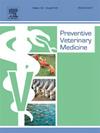Pig survival, average daily gain, and individual antimicrobial treatments from birth to slaughter in Finland
IF 2.2
2区 农林科学
Q1 VETERINARY SCIENCES
引用次数: 0
Abstract
Birth weight appears to be a key indicator for survival and average daily gain (ADG) in piglets. However, parameters associated with piglet antimicrobial treatment are less explored. We assessed the factors influencing piglet survival, ADG, and first individual antimicrobial treatment. Data were collected on sex, weight, litter details, and medication throughout the lifespan of 3991 ear tagged pigs in Finland. Discrete-time survival models were performed for piglet survival and individual antimicrobial treatment as well as a linear regression model for piglet ADG from birth to slaughter. Medium (1 – 1.49 kg) and lightweight (< 1.0 kg) piglets at day 4 had 2.26 and 4.04 times higher odds of dying (in terms of odds for discrete hazards), respectively, than heavyweight (≥ 1.5 kg) piglets. Barrows and antimicrobial-treated suckling piglets had 1.81 and 1.67 times, respectively, higher odds of dying than females and unmedicated piglets. The mean average daily gain from birth to slaughter was 714 g (SD 70.2 g). Pigs born to sows grew 29.2 g/day more than pigs born to gilts, and barrows grew 13.3 g/day better than females, but these results should be interpreted with caution because a considerable number of ear tags lost during the study could have led to selection bias of the pigs with a measured ADG. Altogether 756 piglets received at least one individual parenteral antimicrobial treatment. Antimicrobial-treated pigs were to a considerable extent medicated before weaning mainly for diarrhea and leg problems during two treatment peaks: before day 8 and around weaning. Lightweight piglets at day 4 had 2.35 and piglets born to gilts 1.56 times higher odds of becoming medicated with antimicrobials than heavyweight piglets and piglets born to sows, respectively. Half of the study piglets receiving antimicrobials were treated again later. In summary, our results show that lightweight piglets at day 4 had poorer survival, and they received more antimicrobial treatments than their heavier littermates. Further, gilt offspring were medicated more frequently. This emphasizes the need to direct extra attention to litters born to gilts.
芬兰猪的存活率、平均日增重和从出生到屠宰的个体抗菌治疗
初生体重是仔猪生存和平均日增重(ADG)的关键指标。然而,与仔猪抗菌治疗相关的参数探索较少。我们评估了影响仔猪存活、平均日增重和首次单独抗菌治疗的因素。在芬兰收集了3991头耳标猪的性别、体重、产仔细节和整个生命周期的用药数据。采用离散时间生存模型计算仔猪的生存和单独抗菌药物治疗,并建立仔猪从出生到屠宰的平均日增重的线性回归模型。中型(1 - 1.49 kg)和轻型(<;第4天1.0 kg体重的仔猪死亡几率(以离散危险几率计算)分别是体重(≥1.5 kg)仔猪的2.26倍和4.04倍。母仔猪和未给药仔猪的死亡率分别是母仔猪和未给药仔猪的1.81倍和1.67倍。从出生到屠宰的平均日增重为714 g (SD 70.2 g)。母猪出生的猪比母猪出生的猪长29.2 g/天,母猪出生的猪比母猪出生的猪长13.3 g/天,但这些结果应该谨慎解释,因为研究过程中相当数量的耳标丢失可能导致具有测量ADG的猪的选择偏差。共有756头仔猪接受了至少一次单独的肠外抗菌治疗。在很大程度上,抗菌素处理的猪在断奶前用药,主要是在两个治疗高峰期间腹泻和腿部问题:第8天前和断奶前后。第4天体重轻的仔猪和后备母猪出生的仔猪服用抗菌剂的几率分别是体重重的仔猪和母猪出生的仔猪的2.35倍和1.56倍。接受抗菌剂治疗的仔猪中有一半在随后再次接受治疗。综上所述,我们的研究结果表明,第4天体重较轻的仔猪存活率较低,并且与体重较重的仔猪相比,它们接受了更多的抗菌治疗。此外,后备母猪的后代用药更频繁。这强调了对后备母猪出生的幼崽给予额外关注的必要性。
本文章由计算机程序翻译,如有差异,请以英文原文为准。
求助全文
约1分钟内获得全文
求助全文
来源期刊

Preventive veterinary medicine
农林科学-兽医学
CiteScore
5.60
自引率
7.70%
发文量
184
审稿时长
3 months
期刊介绍:
Preventive Veterinary Medicine is one of the leading international resources for scientific reports on animal health programs and preventive veterinary medicine. The journal follows the guidelines for standardizing and strengthening the reporting of biomedical research which are available from the CONSORT, MOOSE, PRISMA, REFLECT, STARD, and STROBE statements. The journal focuses on:
Epidemiology of health events relevant to domestic and wild animals;
Economic impacts of epidemic and endemic animal and zoonotic diseases;
Latest methods and approaches in veterinary epidemiology;
Disease and infection control or eradication measures;
The "One Health" concept and the relationships between veterinary medicine, human health, animal-production systems, and the environment;
Development of new techniques in surveillance systems and diagnosis;
Evaluation and control of diseases in animal populations.
 求助内容:
求助内容: 应助结果提醒方式:
应助结果提醒方式:


